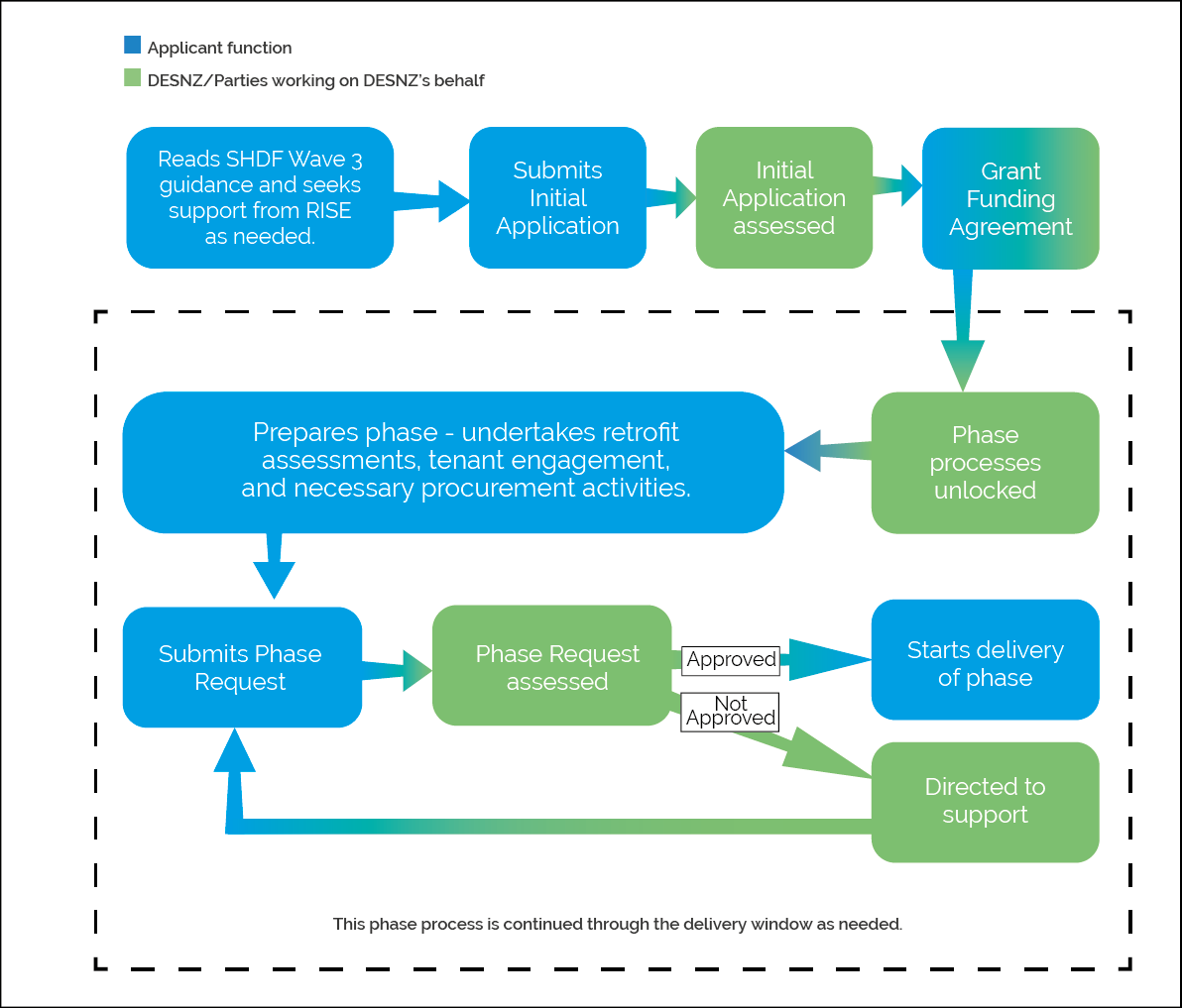
Summary – SHDF Wave 3 Draft Guidance
The Social Housing Decarbonisation Fund (SHDF) provides energy efficiency measures to social housing across England. Wave 3 will run from April 2025 to September 2028, and will provide social housing providers with £1.2 billion of government funding to retrofit their housing stock. You can read the draft guidance in full here.
Headline proposals
- There are two new routes to access funding under Wave 3, via the Challenge Fund and via Strategic Partnerships.
- Wave 3 includes a cost cap of £7,500 of grant funding per home. This cap can be averaged across homes in an application (including across different consortium members).
- There is also an additional £7,500 grant funding cost cap for low carbon heating measures in homes off the gas grid.
- There is a new optional low carbon heating incentive for homes on the gas grid. Up to 10% of homes in an application can gain access to a £20,000 grant fund per home to install low carbon heating measures on the gas grid (instead of the usual £7,500 on the gas grid cost cap).
Main changes from previous waves

Delivery window
The Wave 3 delivery window will run until 30th September 2028. All grant funding for SHDF Wave 3 projects must be transferred to the Grant Recipient and spent by 31st March 2028, and within the financial year the grant funding was allocated, meaning projects can only use co-funding in the final 6 months of delivery.
Project grant funding spend must be aligned to the SHDF spend profile of 40% in FY25/26, 40% in FY26/27 and 20% in FY27/28.
Performance outcomes
Grant Recipients are expected to get homes to EPC C, however DESNZ accept that there may be circumstances where this is not achievable within the cost caps. If this is the case, homes are expected to attain the maximum EPC grade achievable within the cost caps. The 90/kWh/m2/year space heating demand consideration in Wave 2 no longer applies for Wave 3.
Homes which cannot reasonably reach EPC C within the cost cap are exempt from this requirement. However, at Phase Request stage, Challenge Fund Grant Recipients must demonstrate why it would cost over £15,000 to get the home to EPC C).
Cost caps
There is a new single cost cap for energy efficiency measures which is consistent across all homes and does not vary by starting EPC band or wall type as it did in Wave 2. The Wave 3 cost cap is £7,500 of SHDF grant funding from the Government per home. In addition to this government funding, social housing providers must provide a minimum of 50% co-funding. This means that the average capital spend per home will be £15,000 for the installation of fabric efficiency measures (assuming 50% co-funding).
This cap can be averaged across homes in an application (including across different consortium members). Therefore, it is possible for applicants to spend more or less than £7,500 of grant funding per property, as long as the average amount of grant funding spent across an application is less than or equal to the £7,500 cost cap.
In Wave 3, there are also additional cost caps for low carbon heating measures, which are outlined in more detail below.
Additional off gas low carbon heating cost cap
There is an additional £7,500 grant funding cost cap for low carbon heating measures in homes off the gas grid. This will be available in addition to the baseline £7,500 energy efficiency cost cap and can also be averaged out across homes. This means that applicants will be able to access a total of £15,000 of SHDF grant funding from the Government for off gas homes, split into 50% for energy efficiency measures and 50% for low carbon heating. When combined with 50% co-funding, this means that applicants will be able to spend £30,000 per property on off gas homes.
New Wave 3 on gas grid low carbon heating incentive offer
Wave 3 includes a new low carbon heating incentive for on gas grid homes. For up to 10% of the homes in an application, applicants will be able to access a grant of £20,000 per home. The entire £20,000 will come from the Government’s SHDF funding, so there is no co-funding requirement. For homes making use of the £20,000 incentive offer, installation of low carbon heating is mandatory. It is expected that the £20,000 is also used for energy efficiency measures to ensure that bills do not go up.
The only heating systems eligible for this offer are:
- Air source heat pumps
- Ground source heat pumps
- Shared ground loops
- Heat networks.
Summary
Table 1 below provides a summary of the different cost caps operating within SHDF Wave 3.

Eligible measures
Any energy efficiency and heating measures compatible with SAP are eligible under SHDF, excluding systems solely powered by fossil fuels. However, only a limited number of heating systems are eligible for new £20,000 on gas grid low carbon heating incentive offer. Heating systems eligible for this incentive are listed in Section 4.2.
- Solid biomass. Whilst solid biomass is an eligible measure, this is only expected to be installed in exceptional circumstances where heat pumps are unsuitable for the dwelling, and only in rural areas where there are no air quality restrictions.
- Hybrid heat pumps. Hybrids are an eligible measure for homes currently heated by mains gas, however they are not permitted in homes off the gas grid.
- Smart technologies. SAP-eligible technologies which would enable Smart Meter Enabled Thermal Efficiency Ratings (SMETER) (such as smart thermostats) are an eligible measure.
Revisiting homes
Homes previously treated in SHDF Wave 1 or the SHDF Demonstrator are eligible to be treated in SHDF Wave 3 as long as they comply with SHDF Wave 3 eligibility requirements and only where installing low carbon heating measures. Homes treated in SHDF Wave 2 are not eligible.
Minimum number of homes
Wave 3 Challenge Fund applications must include a minimum of 100 eligible social housing properties at EPC band D-G per application. Small social housing landlords (those who own or manage fewer than 1000 homes) can apply with fewer than 100 homes. Strategic Partnership applicants will be expected to propose projects of significant scale, which retrofit thousands of homes.
Application timelines

Eligible properties
All social housing below EPC C is eligible for SHDF Wave 3 funding, apart from homes already retrofitted during Wave 2 of SHDF.
Homes at EPC C or above
In previous Waves of SHDF, homes already at or above EPC band C could only be included on an infill basis. In Wave 3, this is still the case, but there is also another instance whereby homes at EPC C or above can be included. This applies to homes where low carbon heating measures are being installed. In both instances, applications are limited to a maximum of 10% of all homes within the bid being at or above EPC band C.
Infill
Where a small number of properties in a block or terrace are at EPC Band C or above, they can be included in bids where work to those properties enables effective works to social housing below EPC Band C. Challenge Fund Applicants must justify this approach in Phase Requests, including providing the % of properties at EPC Band C or
above. There would need to be a significant reason for inclusion of these properties – any application without appropriate justification will not be successful.
This infill funding can only be used to install insulation, ventilation and low carbon communal heating.
Low carbon heating measures
Homes at or above EPC band C are eligible for the installation of low carbon heating measures. This applies to homes accessing the off-grid low carbon heating cost cap, or the on-grid low carbon heating incentive.
Mixed tenure and non-social homes
Private homes may be eligible for funding under the Wave 3 infill policy on non-social homes. Shared ownership homes also fall under the scope of Wave 3 infill policy.
Infill of non-social homes can only apply:
- In a situation where social homes would be adversely affected without it, for example cases where social homes would not be able to meet EPC C without works taking place on non-social homes, or where works must be undertaken on a whole block for planning or logistical reasons.
- To a maximum of 30% of the homes in the application bid.
- To insulation, associated ventilation, and communal low carbon heating measures.
The requirement for owner occupiers and private rented sector landlords/tenants to contribute to measure costs that applied in previous waves of SHDF no longer applies.
Mixed tenure blocks and terraces are eligible for SHDF funding. In any block/terrace being treated, at least 30% of the homes within the block/terrace must be social homes.

Installers
All installers of energy efficiency measures under SHDF must be TrustMark Registered, certified to MCS (or equivalent) for the technology they are installing. All projects must be compliant with PAS 2035/2030:2019.
Administration and Ancillary Costs (A&A)
A&A costs are expected to be as low as possible, with a requirement that grant funding for A&A comprises no more than 15% of total grant spend by the end of the project.
Interaction with other energy efficiency schemes
Applicants may use funding from other government schemes, such as the Energy Company Obligation (ECO), to support works on the same home but funding from multiple government schemes cannot be used to fund the same individual measure twice.
Retrofit information, support and expertise
Technical assistance for SHDF Wave 3 will be delivered under the name of ‘RISE’ – Retrofit Information, Support and Expertise – through Turner & Townsend.
The Department for Energy Security & Net Zero (DESNZ) expects that Applicants will inform RISE about their intent to apply for SHDF Wave 3. Applicants can do so via the self-assessment form found at www.riseretrofit.org.uk or email rise@turntown.co.uk.
Application Routes
Challenge Fund
The vast majority of applicants are expected to access funding via this route. All Challenge Fund applications that meet the minimum standards of the scheme will be awarded funding (although if oversubscribed, this may not be the amount of funding requested).
Applications are assessed against the following criteria:
- Strategic fit: an assessment of how well the proposal fits with the aims, desired outcomes and eligibility criteria of the SHDF Wave 3 Challenge Fund.
- Delivery forecast: an assessment of the plan for the project, including proposed costs.
- Commercial assurance: an assessment of the feasibility and credibility of the approach to procurement as well as of the proposed contracts required to move to Phase Request stage.
- Delivery assurance: an assessment of the feasibility and credibility of the project including resource; project management strategies; risk and issues management and confidence in delivery of the project.
The phase approach
The Challenge Fund model will be delivered according to a phased approach, whereby groups (or batches) of homes are submitted to DESNZ in phases. Each phase will cover all or a proportion of the homes within a project. DESNZ expects that no project will have more than 10 phases or less than 10% of total homes in any one phase.
Before measures are installed in any homes, a Phase Request covering those homes must be submitted to and approved by DESNZ. The information in each Phase Request should be based on a significant number of completed retrofit assessments to ensure confidence in the accuracy of the information provided. DESNZ suggests that this should cover c.70% of flats in a block, or c.90% of homes where they are spread out.
Applicants will not be required to provide detailed information on specific homes and measures at the initial application stage. Instead, they will simply need to demonstrate that they will be able to deliver a project to the required specifications. More detailed information on homes is required only when applicants submit Phase Requests. Applicants must quantify the mix of measures they are intending to install at Phase Request stage and why they are the most suitable measures.
Figure 1 below sets out the application and delivery process for the Challenge Fund.

Assessment of Phase Requests
Phase requests will be assessed by DESNZ according to the following criteria:
- Strategic fit: an assessment of how well the proposal fits with the aims, desired outcomes and eligibility criteria of the SHDF Wave 3 Challenge Fund.
- Contractor procurement: An assessment of the suitability of the contractors that have been procured for delivery of this phase.
- Delivery assurance and internal resourcing: an assessment of the feasibility and credibility of the project, including organisational design, fraud management and planning.
- Delivery forecast: an assessment of the proposed activities and spend to take place each month.
- Value for money: an assessment of the costs of the proposed measures to be installed, a cost breakdown of the phase and a justification for the cost of the phase.
If a phase request is approved, applicants will be allowed to start delivery on that phase of homes. If it is rejected, applicants will be directed to further and asked to re-submit after making changes.
Payment of the grant
In the Challenge Fund route, Lead Grant Recipients will only be able to draw down up to 20% of their total grant funding award before their Phase Requests are approved; made up of 15% A&A and 5% capital. They will be able to draw down the remainder of the grant following the approval of Phase Requests.
Strategic Partnerships
A small number of Grant Recipients with a proven track record of successful delivery at scale (1000s of properties) can access funding through a Strategic Partnership. To reflect the capability evidenced by these landlords and to support delivery at scale, these Grant Recipients will not be required to provide detail on specific homes and measures until works have been carried out, as part of routine delivery monitoring.
To be eligible for a Strategic Partnership, the Lead Applicant must have delivered on the SHDF Demonstrator, Wave 1, and Wave 2.1 or Wave 2.2, either as the Lead Grant Recipient or as part of a consortium.
Strategic Partnership Applicants will be expected to propose projects of significant scale, retrofitting multiple thousands of homes.
Application process
The application process for Strategic Partnership applications will place a reduced focus on specific project detail and a greater emphasis on evidence of delivery capability.
Strategic Partnerships, applications will be assessed on how well they meet SHDF’s four, equally weighted, strategic priorities. There are up to 10 points available for each strategic priority, so applications which deliver on a greater number of priorities are potentially able to score more highly, but applications that do not deliver on every strategic priority will not be automatically ruled out.
The four strategic priorities are listed below:

Strategic Partnership Lead Applicants will be informed of the outcome of their application before the closure of the Challenge Fund application window. Therefore, any unsuccessful Strategic Partnership Applicants will still have the opportunity to submit an application to the Challenge Fund if their Strategic Partnership application is rejected.
At initial application, Challenge Fund Applicants will not be required to provide information on specific homes to be upgraded or specific measures to be installed. Instead, Applicants will be asked for information to demonstrate that they will be able to deliver a project to the required specifications.
